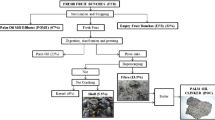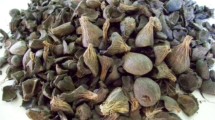Abstract
In this study oil palm shells (OPS) are used as coarse and fine aggregate in making of light weight concrete. OPS are used as aggregate by many researchers but using them as both coarse and fine aggregate in concrete. Concrete with OPS as fine and coarse aggregate are examined for alkali-silicate reaction using concrete motor bar test and concrete prism test. Heat of hydration in lightweight concrete is evaluated with coffee cup calorimeter test. Water absorption test shows OPS has water absorption rate of 20–24% which is very high which helps in internal curing of concrete to takes place which may change the heat of hydration in period of time. Expansion property of mortar or coarse aggregate concrete can be found in mortar bar test and prism bar test. This test reveals the expansion of mortar bar and prism bar is within the permissible limit. Heat of hydration in conventional concrete and OPS lightweight concrete showed the 10–15% time difference in setting time of concrete, difference in heat evolved during OPS lightweight concrete heat of hydration process is 18–22% less than conventional concrete.
Similar content being viewed by others
References
Vandanapu SN, Krishnamurthy M (2018) Seismic performance of lightweight concrete structures. Adv Civ Eng 2018
Swamynadh V, Muthumani K (2018) Properties of structural lightweight concrete containing treated oil palm shell as coarse aggregate. Asian J Civ Eng 19(6):673–678
Teo DCL, Mannan MA, Kurian VJ, Program CE (2006) Structural concrete using oil palm shell ( OPS ) as lightweight 30:251–257
Teo DCL, Mannan MAÃ, Kurian VJ, Ganapathy C (2007) Lightweight concrete made from oil palm shell ( OPS ): Structural bond and durability properties 42:2614–2621
Hung K, Alengaram UJ, Zamin M, Yong M, Liu J, Lim J (2016) Assessing some durability properties of sustainable lightweight oil palm shell concrete incorporating slag and manufactured sand. J Clean Prod 112:763–770
Li YL, Zhao XL, Singh RKR, Al-saadi S (2016) Thin-walled structures experimental study on seawater and sea sand concrete fi lled GFRP and stainless steel tubular stub columns 106:390–406
Liu X, Du H, Zhang M (2015) A model to estimate the durability performance of both normal and light-weight concrete. Constr Build Mater 80:255–261
Pagliolico SL, Lo VRM, Torta A, Giraud M, Canonico F, Ligi L (2015) A preliminary study on light transmittance properties of translucent concrete panels with coarse waste glass inclusions. Energy Procedia 78:1811–1816
Halikowski JS et al. REPORT 733 high-performance/high-strength lightweight concrete for bridge girders and decks
Mo KH, Chin TS, Alengaram UJ, Jumaat MZ (2016) Material and structural properties of waste-oil palm shell concrete incorporating ground granulated blast-furnace slag reinforced with low-volume steel fi bres. J Clean Prod 133:414–426
Karthiyaini S (2012) Physicochemical properties of alkali activated Fly ash based geopolymer concrete : a review
Amer M, Farzadnia N, Abdullah A, Ali A, Demirboga R (2015) Development of high strength alkali activated binder using palm oil fuel ash and GGBS at ambient temperature. Constr Build Mater 93:289–300
Author information
Authors and Affiliations
Corresponding author
Additional information
Publisher’s Note
Springer Nature remains neutral with regard to jurisdictional claims in published maps and institutional affiliations.
Rights and permissions
About this article
Cite this article
Vandanapu, S., Muthumani, K. Heat of Hydration and Alkali- Silicate Reaction in Oil Palm Shell Structural Lightweight Concrete. Silicon 12, 1043–1049 (2020). https://doi.org/10.1007/s12633-019-00202-9
Received:
Accepted:
Published:
Issue Date:
DOI: https://doi.org/10.1007/s12633-019-00202-9




